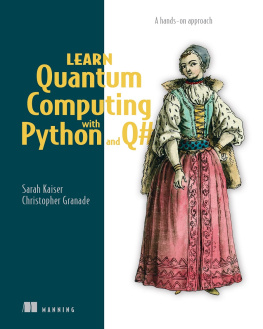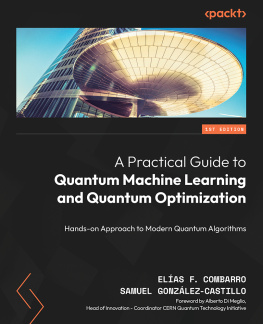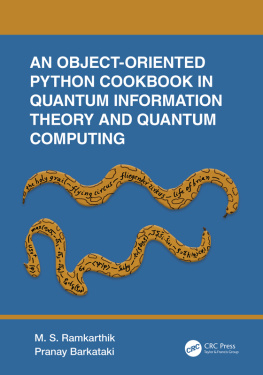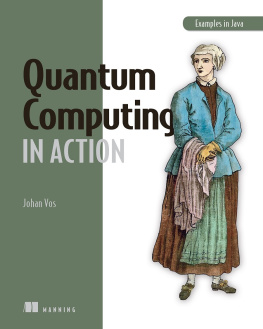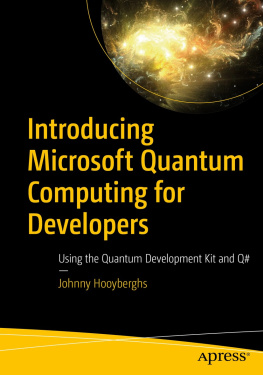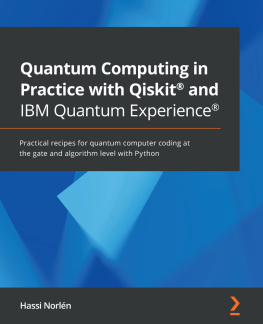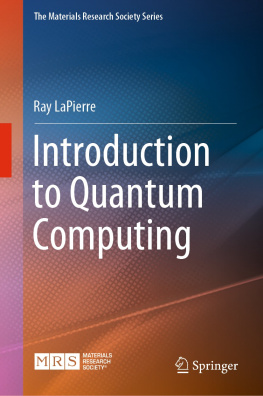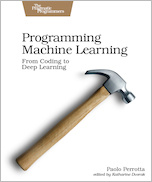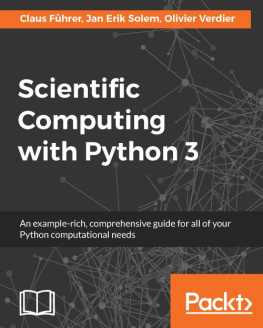Sarah Kaiser - Learn Quantum Computing with Python and Q#: A Hands-on approach
Here you can read online Sarah Kaiser - Learn Quantum Computing with Python and Q#: A Hands-on approach full text of the book (entire story) in english for free. Download pdf and epub, get meaning, cover and reviews about this ebook. year: 2021, publisher: Manning Publications Co., genre: Children. Description of the work, (preface) as well as reviews are available. Best literature library LitArk.com created for fans of good reading and offers a wide selection of genres:
Romance novel
Science fiction
Adventure
Detective
Science
History
Home and family
Prose
Art
Politics
Computer
Non-fiction
Religion
Business
Children
Humor
Choose a favorite category and find really read worthwhile books. Enjoy immersion in the world of imagination, feel the emotions of the characters or learn something new for yourself, make an fascinating discovery.
- Book:Learn Quantum Computing with Python and Q#: A Hands-on approach
- Author:
- Publisher:Manning Publications Co.
- Genre:
- Year:2021
- Rating:3 / 5
- Favourites:Add to favourites
- Your mark:
- 60
- 1
- 2
- 3
- 4
- 5
Learn Quantum Computing with Python and Q#: A Hands-on approach: summary, description and annotation
We offer to read an annotation, description, summary or preface (depends on what the author of the book "Learn Quantum Computing with Python and Q#: A Hands-on approach" wrote himself). If you haven't found the necessary information about the book — write in the comments, we will try to find it.
Sarah Kaiser: author's other books
Who wrote Learn Quantum Computing with Python and Q#: A Hands-on approach? Find out the surname, the name of the author of the book and a list of all author's works by series.
Learn Quantum Computing with Python and Q#: A Hands-on approach — read online for free the complete book (whole text) full work
Below is the text of the book, divided by pages. System saving the place of the last page read, allows you to conveniently read the book "Learn Quantum Computing with Python and Q#: A Hands-on approach" online for free, without having to search again every time where you left off. Put a bookmark, and you can go to the page where you finished reading at any time.
Font size:
Interval:
Bookmark:
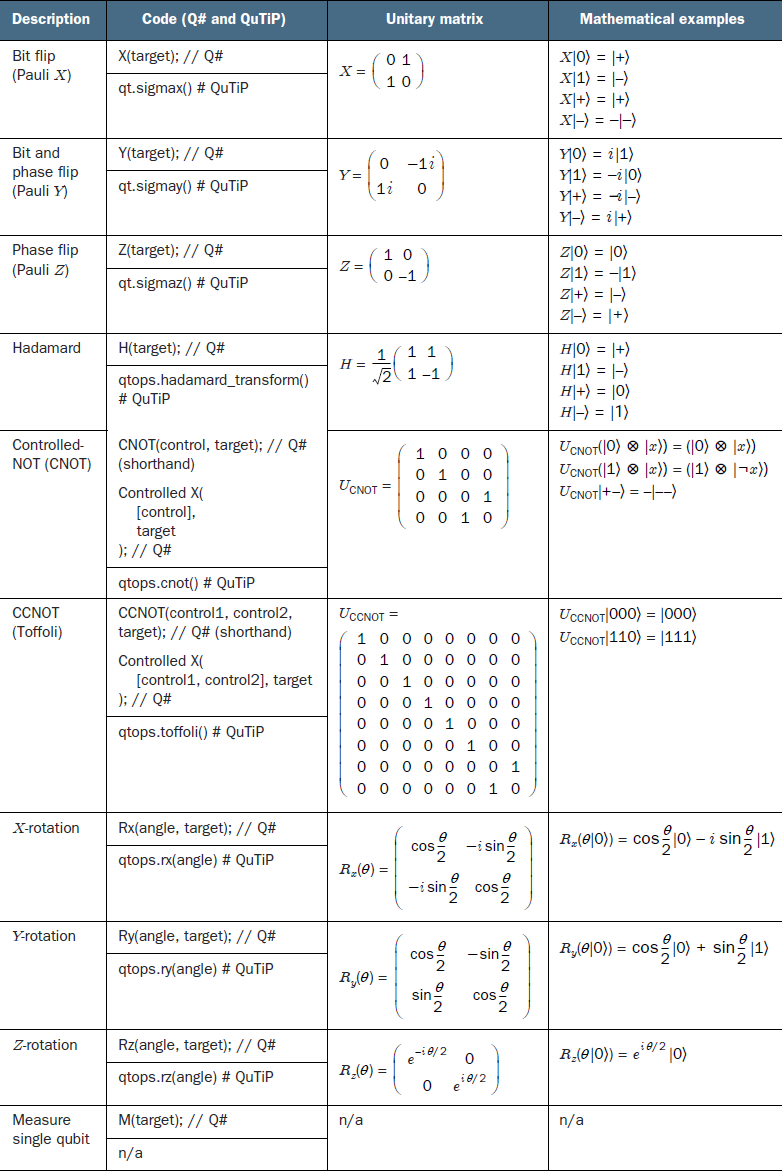

A Hands-on approach
Sarah C. Kaiser and Christopher E. Granade
To comment go to liveBook

Manning
Shelter Island
For more information on this and other Manning titles go to
www.manning.com
For online information and ordering of these and other Manning books, please visit www.manning.com. The publisher offers discounts on these books when ordered in quantity.
For more information, please contact
Special Sales Department
Manning Publications Co.
20 Baldwin Road
PO Box 761
Shelter Island, NY 11964
Email: orders@manning.com
2021 by Manning Publications Co. All rights reserved.
No part of this publication may be reproduced, stored in a retrieval system, or transmitted, in any form or by means electronic, mechanical, photocopying, or otherwise, without prior written permission of the publisher.
Many of the designations used by manufacturers and sellers to distinguish their products are claimed as trademarks. Where those designations appear in the book, and Manning Publications was aware of a trademark claim, the designations have been printed in initial caps or all caps.
Recognizing the importance of preserving what has been written, it is Mannings policy to have the books we publish printed on acid-free paper, and we exert our best efforts to that end. Recognizing also our responsibility to conserve the resources of our planet, Manning books are printed on paper that is at least 15 percent recycled and processed without the use of elemental chlorine.
| Manning Publications Co. 20 Baldwin Road Technical PO Box 761 Shelter Island, NY 11964 |
Development editor: | Dustin Archibald |
Technical development editor: | Alain Couniot and Joel Kotarski |
Review editor: | Ivan Martinovi |
Production editor: | Deirdre S. Hiam |
Copy editor: | Tiffany Taylor |
Proofreader: | Katie Tennant |
Technical proofreader: | Krzysztof Kamyczek |
Typesetter: | Dennis Dalinnik |
Cover designer: | Marija Tudor |
ISBN: 9781617296130
We dedicate this book to the next generation of quantum developers who are working to make this field a safer and more inclusive space.
For most of its history, quantum computing was a field for physicistsperhaps a few having a proclivity for computer science, but not necessarily so. The popular textbook, Quantum Computation and Quantum Information, by Michael A. Nielsen and Isaac L. Chuang, is still considered the go-to textbook, and was written by two quantum physicists. To be sure, computer scientists have always been around, but some theoreticians wear how few lines of code they have written as a badge of honor. This is the quantum world myself, Kaiser, and Granade came of age in. I could easily shake my fist at the new cohort of students and yell, When I was your age, we didnt write codewe choked on chalk dust!
I met Chris Granade while we were both graduate students. Back then we wrote academic journal articles for physics journals that contained lines of code which were rejected for being not physics. But we were not deterred. And now, many years later, this book represents for me the ultimate vindication! This is a book that teaches you everything youll ever want and need to know about quantum computing, without the need for physicsthough, if you really want to know the connection back to physics, Kaiser and Granade offer that as well  ? There are also emojis
? There are also emojis  !
!
Ive come a long way since then, and I owe much to Granade, as does the field of quantum computing, for showing many of us that between the quantum and the computing, there is more than just theorems and proofs. Kaiser has also taught me more than I thought existed about the need for the software engineers touch in developing quantum technology. Kaiser and Granade have turned their expertise into words and lines of code so all can benefit from it, as I have.
Though the goal was to create not a textbook, this book could certainly be used as such in a university lecture as introductions to quantum computing shift from physics departments to schools of computer science. There is immense growing interest in quantum computing, and the majority of it is not coming from physicssoftware developers, operations managers, and financial executives all want to know what quantum computing is about and how to get their hands on it. Gone are the days of quantum computing as a purely academic pursuit. This book serves the needs of the growing quantum community.
Though Ive alluded to the decreasing proportion of physicists in the field of quantum computing, I dont want to discount them. Just as I was once a software development Luddite, this book is really for anyoneespecially those already in the field who want to learn about the software side of quantum computing in a familiar setting.
Fire up your favorite code editor and get ready to print (Hello quantum world!).
Chris Ferrie, PhD
Associate Professor, Centre for Quantum Software and Information
Sydney, NSW, Australia
Quantum computing has been our jam for more than 20 years combined, and we are passionate about taking that experience and using it to help more folks get involved in quantum technologies. We completed our doctoral degrees together, and while doing so, we struggled through research questions, pun competitions, and board games, helping to push the boundaries of what was possible with qubits. For the most part, this meant developing new software and tools to help us and our teams do better research, which was a great bridge between the quantum and computing parts of the subject. However, while developing various software projects, we needed to teach our developer colleagues what we were working on. We kept wondering, Why isnt there a good book for quantum computing thats technical but not a textbook? What you are currently looking at is the result. 
Weve written the book to be accessible to developers, rather than writing it in the textbook style that is so typical in other quantum computing books. When we were learning quantum computing ourselves, it was very exciting but also a bit scary and intimidating. It doesnt have to be that way, as a lot of what makes quantum computing topics confusing is the way they are presented, not the content.
Unfortunately, quantum computing is often described as weird, spooky, or beyond our understanding, when the truth is that quantum computing has become quite well understood during its 35-year history. Using a combination of software development and math, you can build up the basic concepts you need to make sense of quantum computing and explore this amazing new field.
Font size:
Interval:
Bookmark:
Similar books «Learn Quantum Computing with Python and Q#: A Hands-on approach»
Look at similar books to Learn Quantum Computing with Python and Q#: A Hands-on approach. We have selected literature similar in name and meaning in the hope of providing readers with more options to find new, interesting, not yet read works.
Discussion, reviews of the book Learn Quantum Computing with Python and Q#: A Hands-on approach and just readers' own opinions. Leave your comments, write what you think about the work, its meaning or the main characters. Specify what exactly you liked and what you didn't like, and why you think so.

